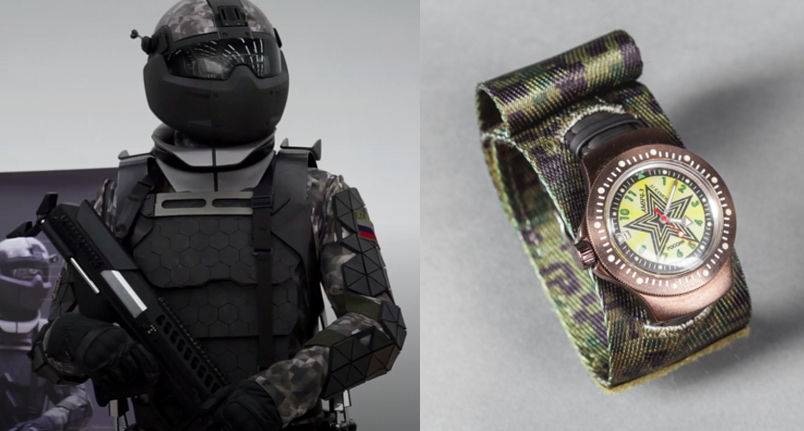
Futuristic Russian Military Suit Gets Nuclear-Proof Upgrade

A high-tech, Russian "soldier of the future" combat suit just got a gear upgrade, with a wristwatch capable of withstanding nuclear blasts.
Newly added to the "Ratnik" military kit — a complex multi-system array of wearable and portable combat gear — the mechanical, self-winding watch weighs about 4 ounces (100 grams) and can withstand destructive electronic pulses used in warfare "and even consequences of a nuclear blast," representatives of the Rostek State Corporation, developers of the Ratnik kit, said in a statement.
"If a soldier is exposed to electromagnetic emission of a nuclear bomb, the watch will continue to operate without any interruption," according to Oleg Faustov, a chief designer of life support systems for tactical gear at Rostek. The statement did not describe any other gear in the Ratnik kit as impervious to the effects of a nuclear explosion, however. [The 20 Weirdest Military Weapons]
Five integrated systems incorporating 59 items — including weapons and devices for protection, communication and optical enhancement — make up the Ratnik combat kit, which can operate under any type of weather conditions and may be used around the clock, the Russian news agency TASS reported.
A more advanced version of the combat gear, described as Ratnik-3, is expected to be unveiled in 2020 and will include a sophisticated suite of operating networks built into a titanium frame, Rostek representatives said on Sept. 29. This so-called "combat suit of the future" will be about 30 percent lighter than the current Ratnik kit, and it will incorporate a jointed exoskeleton with devices for controlling the suit's microclimate and monitoring the wearer's health, along with a digital display system for a helmet face shield or goggles, according to TASS.
The wristwatch may currently be the only device in the Ratnik kit built to emerge intact after a nuclear blast, but the looming threat of nuclear weapons has certainly been gathering more attention on the global stage in recent months.
In January, a consortium of scientists and experts in charge of the "Doomsday Clock," a fictional timepiece counting down the minutes to humanity's destruction, moved its hands 30 seconds closer to midnight — absolute destruction — in part to reflect growing concerns about the threat of nuclear war.
Sign up for the Live Science daily newsletter now
Get the world’s most fascinating discoveries delivered straight to your inbox.
More recently, missile tests in North Korea rekindled fears around the world about the possibility of their using long-range nuclear weapons. President Donald Trump has further stoked fears with promises to increase the U.S. nuclear arsenal "nearly tenfold," a plan that surprised many of his closest advisors, NBC reported Oct. 11.
Original article on Live Science.

Mindy Weisberger is an editor at Scholastic and a former Live Science channel editor and senior writer. She has reported on general science, covering climate change, paleontology, biology and space. Mindy studied film at Columbia University; prior to Live Science she produced, wrote and directed media for the American Museum of Natural History in New York City. Her videos about dinosaurs, astrophysics, biodiversity and evolution appear in museums and science centers worldwide, earning awards such as the CINE Golden Eagle and the Communicator Award of Excellence. Her writing has also appeared in Scientific American, The Washington Post and How It Works Magazine. Her book "Rise of the Zombie Bugs: The Surprising Science of Parasitic Mind Control" will be published in spring 2025 by Johns Hopkins University Press.









